Welcome rain overnight for Sydney and showers on the way for Brisbane.
Perfect summer conditions in the garden this weekend. So what are we waiting for? Let's get gardening!
It's time to
Prune
Prune Agapanthus flower heads to prevent seeding through the garden and bush.
Prune lavender into globes and dry flowers to use in potpourri.
If leaves get sunburned, don’t prune them off. The scorched leaves will protect those beneath from further scorch on the next blasting hot day. The plant
may find it hard to recuperate from two burns.
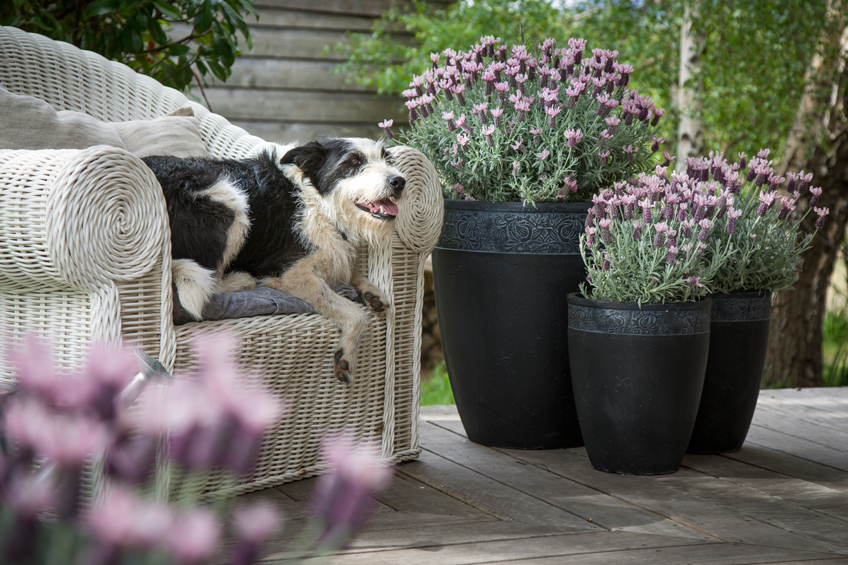
Perfect for the potted garden. Lavendula 'Ghostly Princess'.
Sow
Sow seeds of next winter’s vegetables, such as cabbage, broccoli, kale, cauliflowers and lettuce, into seedling trays. Keep in a shaded spot.
Feed
Feed hungry hibiscus, passionfruit, dipladenia and tomatoes with a fertiliser high in potassium.
Feed palms, ferns and salad greens with seaweed, worm juice or fish emulsion.
Research
Check nursery catalogues and order bulbs and perennials to plant out in autumn. The earlier you make you decision the more likely your favourites wont
be sold out!
Take care
Be vigilant against rust on frangipani, canna and fuchsia. Spray with Eco-fungicide, and bin any fallen infected leaves.
Bush Garden
Morning Flag Iris Orthrosanthus multiflorus
A native grass-like plant from Western Victoria to Kangaroo Island, SA to the Stirling Ranges in WA.
Its clumping and spreading habit makes it an ideal selection for under planting trees, covering and stabilising embankments, massed ground cover and a
great alternative to agapanthus, it’s also great in pots.
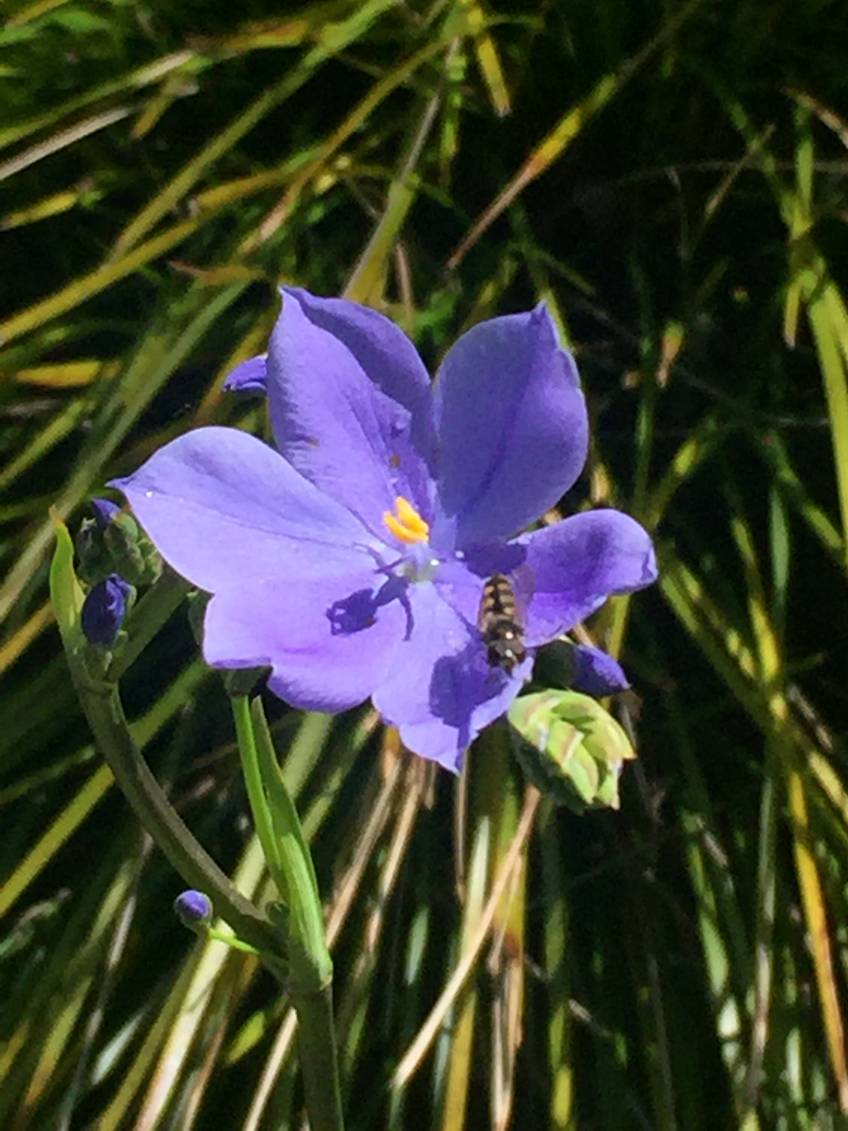
Morning Flag Iris, Orthrosanthus multiflorus. Photo - Graham Ross
The permanent grey-green strappy leaves grow to 1m but it is the beautiful sky blue flowers that stand proud or above the leaves that are the bonus with
this native iris. While each bloom only lasts a day it is replaced with many more each day right through spring and summer for a fantastic display.
This Morning Flag Iris is disease resistant, hardy and low maintenance requiring only an annual removal of spent flowers and old leaves in late summer
autumn.
It is variable as to soil type and pH levels, enjoying sandy loam through to well -drained heavier clay loams to grow well. While often seen in bush gardens
in the shade of tall trees it is hardy in full sun locations.
While it is generally seen massed planting in natural landscaped gardens it is also suited to cottage perennial gardens and growing in containers. It doesn’t
have spines or a sharp edge to the leaf making it ideal to plant in playgrounds.
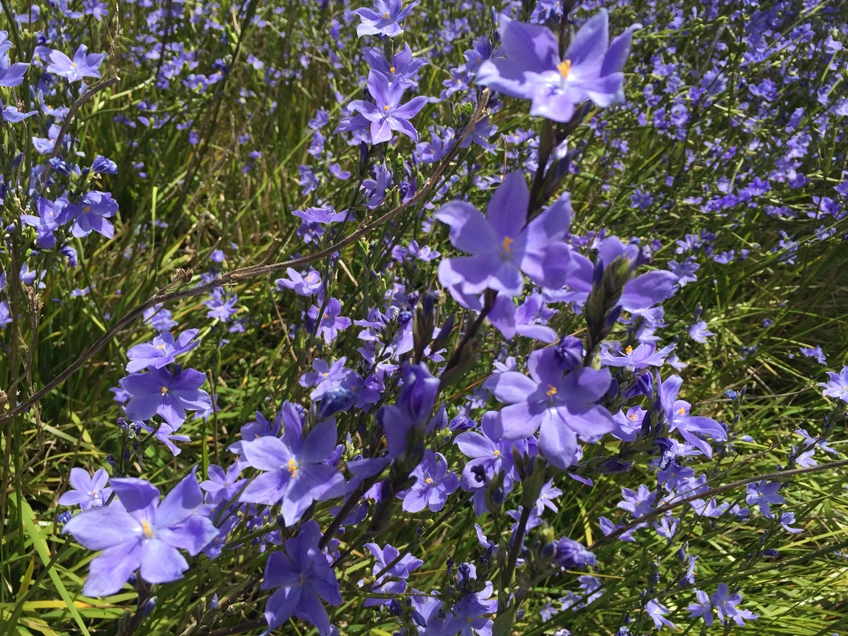
Its clumping and spreading habit makes it an ideal selection for under planting trees. Photo - Graham Ross
Bugwatch
Protecting Soil in Heat and Rain
We often mention the need to mulch gardens to protect the integrity of the soil.
In extreme heat, especially when combined with hot westerly winds, can dry soils, removing moisture at such a speed, plant roots will die from shrinking
cracked soils, worms and other beneficial insects and creatures will die. Then wind will then erode the soil leaving you with a depleted skeletal useless
soil lacking structure, nutrients, and organic matter. A layer of mulch prevents this damage.
In heavy rain mulch will protect the soil from erosion and the loss of valuable topsoil.
In light showers mulch will be absorbed adding moisture to the soil acting as a blanket protecting the soil surface and all that’s in it. Mulch needs to
be applied at between 3-4cm in depth, not any thicker as was the case a few years ago.
It is preferable that your mulch is organic, biodegradable, a natural material possibly a recycled or repurposed waste product from forestry or farming.
Sugarcane is the most popular followed by nitrogen filled lucerne, rice or wheat straw. Pea straw is popular in agricultural areas as a by-product from
agriculture.
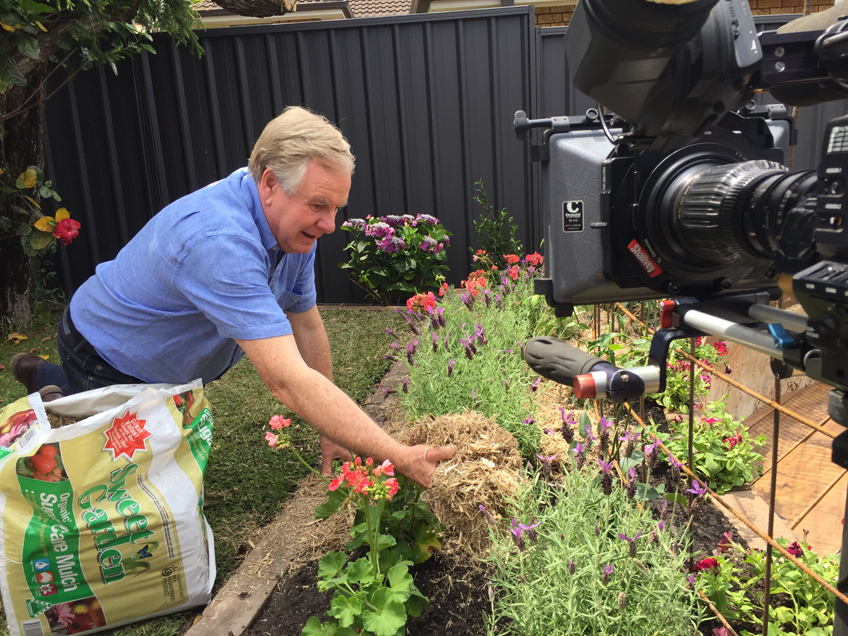
Graham on the set showing us how it's done with sugar cane mulch.
Pine bark is available in many different grade sizes but can pull nitrogen out of the soil as it breaks down over time requiring the addition of extra
nitrogen rich fertiliser. Cypress bark is excellent for native plants and where its termite resistant qualities are needed.
Eucalyptus mulch, bush chip and shredded street tree prunings are also suitable but determine what trees are included in the product and not camphor laurel
or other undesirable timbers. Manure mulches add nutrition but are a more expensive option.
Avoid using cut grass as a mulch as it generates substantial heat as it decomposes and adds excess nitrogen.
In the Veggie Patch
Harvesting Full Flavoured Tomatoes
These are the tomato fruit harvested from the seedling I was given by Bruno at Heritage Nursery in Yarralumla during the Canberra Home Show last September.
13-14 weeks to harvest.
The variety, he’s quaintly called ‘Donkey Balls’ because of the distinctively shaped fruit, is producing 1+kg fruit in pairs up and down the plant. It
is a solid red flesh, with no air gaps or hollows and few seeds. Very juicy and extremely tasty when ripe.
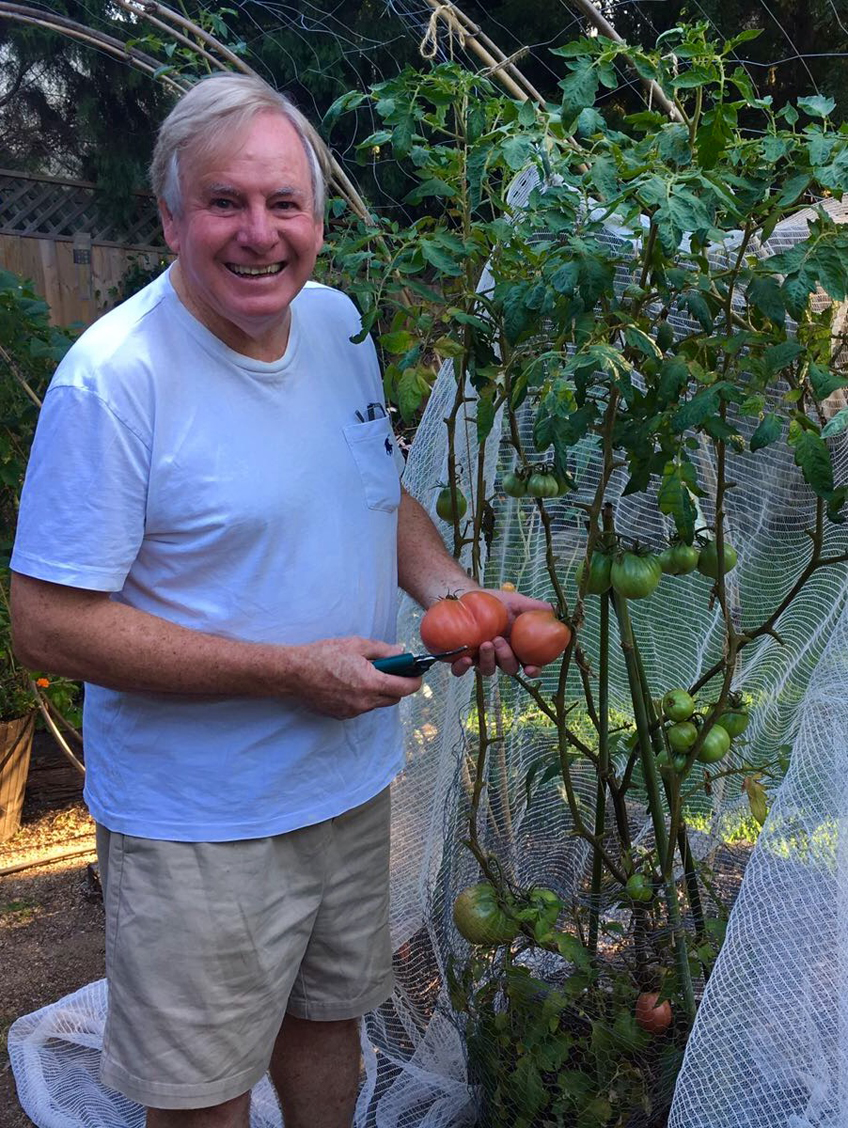
Yes, i think you can see how they got their name....
The variety appears to be of Greek origin as are many popular home grown selections like ‘Arthur’s Big Greek Tomato’ sold exclusively at Tim’s Garden Centre
and proved to be a huge hit with those in the Macarthur region.
Most of these large soft- skinned solid delicious tomatoes will never appear in a greengrocer let alone a supermarket because they are too big, too soft
to travel and can only be harvested ripe to maximise the flavour a few metres from your back door and the kitchen.
Maturity in tomatoes to achieve a deep red, bright yellow, glowing pink or the dark brooding purplish ruby-red of Black Russian, can only be achieved when
the sunshine interacts with the hormones and organic chemicals in the fruit to ripen the sugars, natural acids and aromatic juices to create a full
flavour. No ethylene gas, even though it’s a harmless naturally occurring substance, injected into a truck or shed full of green tomatoes will achieve
the same flavour ever, you just end up with a hard, or firm red fruit with little if any flavour. Many believe a insipid tomato.
Only home grown tomatoes, harvested from the vine when ripe, can achieve the full flavour, sweetness, nutritional goodness we remember, expect and deserve
today in fresh fruit.
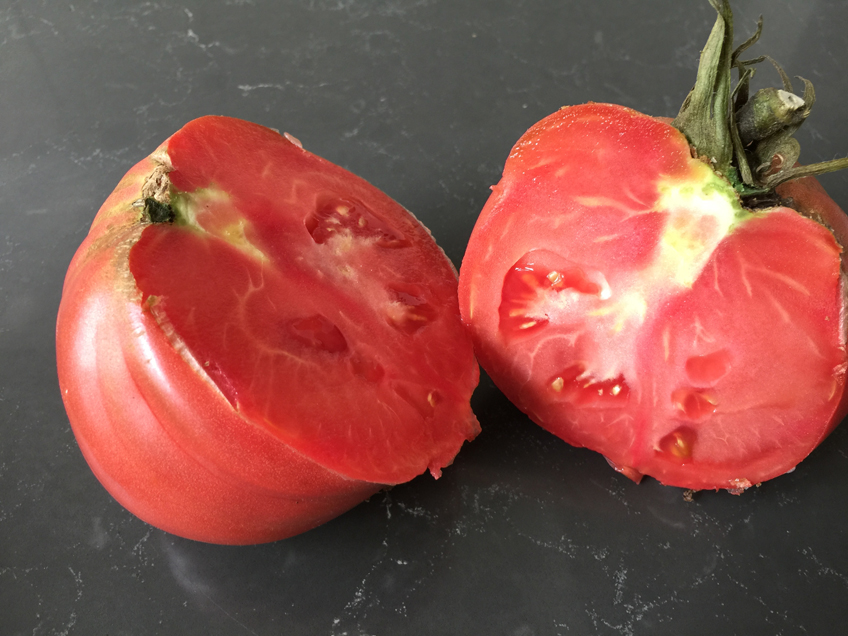
Thick, juicy flesh full of flavour. Photo - Graham Ross.
Garden News
May Gibbs' 140th birthday - Sunday 17 January
Australia's first full-time, professionally trained children's book author and illustrator, May Gibbs was born 140 years ago.

Happy birthday, May Gibbs.
In celebration of May Gibbs' life and work the State Library is hosting a free display featuring iconic artwork from the collection. The display features
original illustrations and beautiful reproductions from May Gibbs’ much-loved children’s books.
Although most Australians know her iconic Gumnut Babies and Snugglepot and Cuddlepie characters, many don't know the fascinating story of May Gibbs herself.

May Gibbs' famous Gumnut Babies. Image care of ABC
An incredible businesswoman, May Gibbs supported herself throughout her career and only married later in life. During the First World War, she designed
a series of popular postcards and bookmarks for soldiers overseas. About Us, May Gibbs' first published book (London, 1912) remains largely unknown
to Australian audiences. She was also an early environmentalist and generous philanthropist.
Come away with us
The Great British Garden Tour of Scotland & Wales and the Hampton Court Flower Show
The new Scotland & Wales tour includes public and private, grand and intimate, walled and wooded gardens in Northern England, Wales and Scotland. High summer brings exhuberant borders,
a flourish of roses and spectacular weather for sightseeing.
Don't miss out on this fantastic tour. Go to the Ross Tours website, or call Royce or Roslyn at Ross Tours on 1300 233 200.
